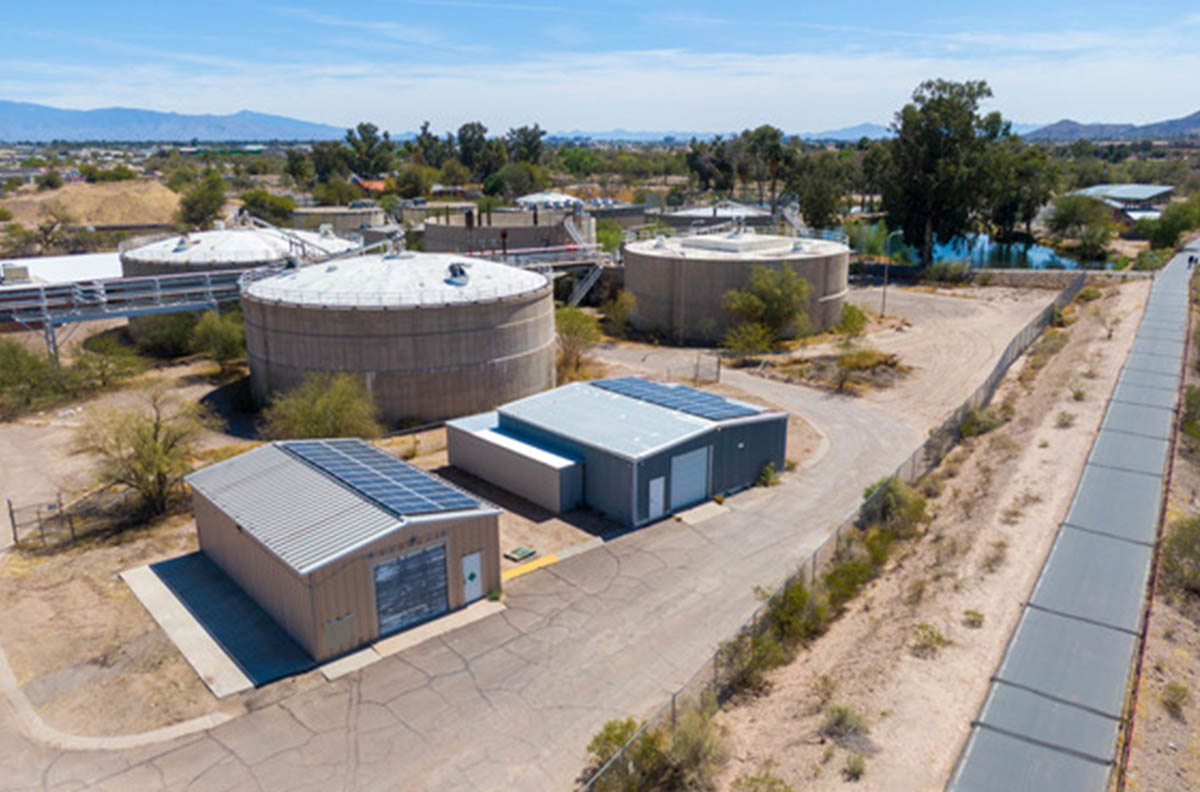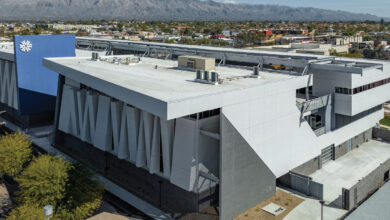
Solar-Powered Warehouses Reflect Pima County’s Smart Sustainability Commitment
The metal roof of the warehouse glints in the afternoon sun. At first glance, there’s nothing unusual about it or the nearly identical building that sits beside it.
Zoom out, though, and the picture becomes clearer. These two small buildings sit on the western edge of the site of the former Roger Road Wastewater Reclamation Facility, which closed more than a decade ago. They’re the only new structures that have been built here in years.
And while the rest of the sprawling industrial site stands vacant, these two buildings are in active use. Pima County Facilities Management built these two small storage spaces as an energy-efficient, cost-effective solution to an ongoing dilemma faced by the Pima Animal Care Center.
That dilemma was simple: PACC needed a storage facility to keep extra food and toys, but the cost of building and maintaining a separate building seemed formidably expensive, considering how humble the facility’s needs would be.
Enter Facilities Management. It was able to set up these two miniature warehouses at a price tag of around $100,000, using in-house resources and a standing electrical supplies contract. In the world of construction, that’s a steal – the good kind.
“We had the ability to leverage the most effective tech onsite, so we opted for building a solar system, using batteries, and installing high-quality equipment,” said Eric Wilson, energy management specialist at Facilities Management.
Bright silver photovoltaic panels adorn the southern half of each warehouse’s roof, providing both facilities with the power they need to operate. Any energy that isn’t used immediately is stored in the warehouses’ state-of-the-art battery system.
“Every time I come in here, it’s like finding a gem,” Wilson said, looking with pride at the smart-looking power setup that runs the southernmost of the two warehouses, the one that keeps the pet food cold.
Brand-new LED lights automatically switch on to greet visitors, then switch themselves off to save power. A Tesla battery charge controller keeps everything on track. There are no windows, which helps to control the warehouse’s temperature and reduces its energy needs.
“This has remote monitoring, so we can live-track all of our power consumption,” Wilson said.
If Facilities had opted for a more traditional utility setup, rather than solar, Wilson said, the cost tag for initial installation would have been closer to $160,000 – not to mention an average of $300 a month to power the two warehouses. Now, the two buildings essentially run themselves.
Inside the first warehouse lay high stacks of plastic-covered palettes. Names familiar to any pet owner peep out from the cans: Royal Canin, Hill’s, Greenies, Purina. An energy-efficient air conditioner runs around the clock to keep the food at a safe temperature.
The other warehouse, a few steps to the north, doesn’t need a cooling system. Instead of food, this facility is filled with boxes to delight pets of all kinds: dog crates, cat towers, lamp stands for reptiles. There’s even a mini trailer for dogs that hitches up to a bicycle.
A few times a week, volunteers from PACC bustle in and out of these warehouses to collect what they need for the week. A radio blares to discourage intruders.
“This warehouse plays a key role in our outreach program,” said Kayleigh Murdock, PACC’s public information officer.
“Having somewhere safe, secure, and climate-controlled to store items like pet food and other donations increases our ability to provide these key resources to folks in need in our community, and the fact that we’re able to do it in an environmentally responsible way makes it all that much better.”
The two warehouses aren’t the only thing that’s changing at the long-defunct site of the former Roger Road plant. The county received a grant from the EPA in 2024 to clean it up and Pima County Wastewater Reclamation has been holding public workshops as it considers ways to redevelop the site.
Wilson said that if a time comes when PACC no longer needs the storage facilities, the solar equipment can easily be relocated to another site. For now, though, they’re here to stay.
As these two mini warehouses demonstrate, even the most unlikely space can be transformed into something that benefits the community. They also illustrate the County’s commitment to finding economical – and environmentally friendly – solutions whenever possible.
It just goes to show that even the most ordinary-looking building can harbor a few surprises.





